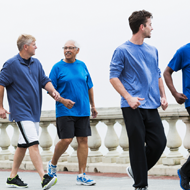We are creatures of habit for many reasons, including chemical. Our brains are wired to crave anything that gives us pleasure, even if it’s not good for us.
That chemical reward is one of the primary reasons breaking bad habits is so difficult. Even so, with time, effort, and intention, we can eliminate habits that are detrimental to health and form new habits that support well-being. The following suggestions can make the going a little easier.
The Three R’s
The Centers for Disease Control and Prevention offers suggestions for improving eating habits that apply to any habit you would like to address. The key is to Reflect, Replace, and Reinforce.
- Reflect on all of your specific habits, both bad and good, and your common triggers.
- Replace your unhealthy habits with healthier ones.
- Reinforce your new, healthier habits.
Cue your behavior changes
Pay special attention to the cues that trigger the habit you want to change and plan how you want to manage those cues.
Ask yourself these questions for each "cue":
- Is there anything I can do to avoid the cue or situation?
- For things I can't avoid, can I do something differently that would be healthier?
A helpful technique is to picture yourself doing something different after a cue – a new, healthier behavior or removing yourself from the tempting situation, for example - and asking yourself how you feel (or will feel) about your new, healthier habit. This visualization will make you more conscious of the cue and your automatic behavior and provide you with an alternative behavior – you’ll be acting instead of reacting.
Some examples of cued behavior and alternatives are:
- Watching TV cues you to reach for chips. You can snack on fruit or a healthy drink.
- You’ve decided (again) to wake up early to exercise. But when you hear your alarm go off, you hit the snooze button. Try putting your clock across the room or make a plan to meet a friend.
- You stop for gas on a long car ride, and crave your favorite salty and sugary snacks. Instead: buy or bring dried fruit and nuts as a treat.
- After returning from work, you flop on the couch and turn on the TV. Try changing clothes and going for a quick walk instead.
- After a long day at work, you walk in the door and see your partner on the couch. Once you sit down, it becomes harder to get up again and you start thinking about ordering dinner. Instead, take a quick walk before coming in the house or go grocery shopping or make dinner together.
Habits can be linked in our minds to certain places and activities, so pay attention to what you are doing and where you are when you receive a cue. Note how you are typically feeling when you are triggered. And remember, both environmental and internal cues can trigger a habitual response.
The U.S. Department of Health and Human Services worksheet Changing Your Habits: Steps to Better Health offers strategies to help you improve your eating and physical activity habits and outlines four stages people may experience when changing a health behavior which include:
- Contemplation
- Preparation
- Action
- Maintenance
After you identify your stage of change, you will find tips on how to overcome barriers to healthy habits and stay on track once your good habit begins to form, and move you along your journey to wellness.
